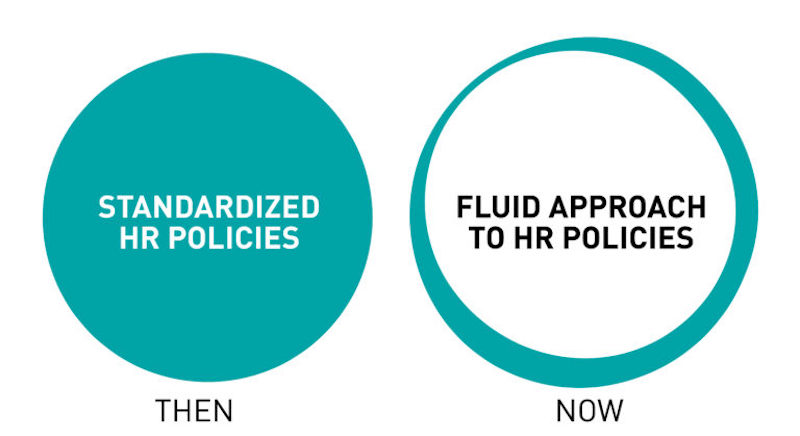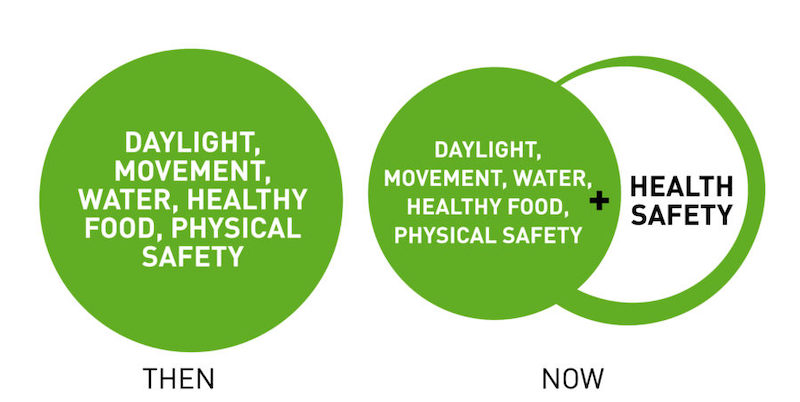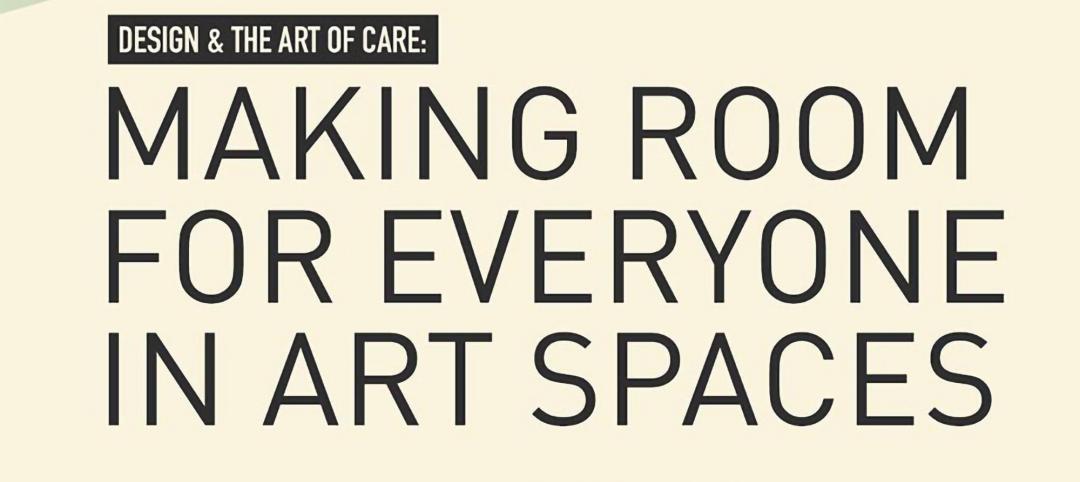As we return to our offices, some workplace changes will be necessary in the short term. Others will last for decades, but the fundamental pillars of work—organizational health, wellness, space, and technology—will endure, even as your company decides how best to build on them.

Organizational health
Thoughtful consideration of your organizational culture—what brings out the best in your people so you can achieve your goals—has always been foundational to thoughtfully designed workplaces.
Many companies have witnessed the agility, adaptability, and resilience of their workforce. Leadership may be surprised by what’s working better than before. Now is the time to take stock of these new habits, embrace what’s working well and address what isn’t. This could include flexible (rather than standardized) HR and operational policies, especially around working from home (WFH). Evaluate what roles and responsibilities are well-suited to part or full-time WFH. Could your company optimize skills and contributions of introverts by allowing more WFH? These organizational decisions will impact your space and technology needs and your ability to recruit and retain talent. Letting go of “that will never work here,” can help you envision the future of your company’s lifestyle of work.

wellness
Access to daylight and healthy food, opportunity to move around throughout the day, good indoor air quality, and the physical safety of your employees have always been key workplace considerations. Your employees may return to the office with a new appreciation for diversifying how they work (sitting v. standing at a counter) and how they schedule breaks, meals, and exercise throughout their days.
Unexpected public health emergencies are a new reality, and people will need a sense of health safety as well. Upgrading your facilities’ air filtration system is one consideration. New protocols like wiping down shared equipment after use (like at the gym) can reinforce the message that everyone is responsible for the day-to-day cleanliness of the workplace, instead of relying solely on after hours crews. Additional measures like touchless fixtures and appropriate physical distancing in common areas and lunchrooms may enhance your employees’ sense of health safety. Offering fruit and other healthy snacks doesn’t need to stop in the Covid-19 era, but there are opportunities to re-think how these get distributed or shared.
The push for more anti-microbial materials is already on but implementing these materials should be thoughtfully researched; some (like copper) naturally break down bacteria; others simply contain unhealthy additive chemicals.

Space
Humans are social creatures. Having spaces to gather—socially and collaboratively—is how we find common ground, establish and nurture relationships, and get things done. But this is a good time to reconsider why people need and want to come to the office. What are the spaces/amenities/ tools/equipment/events that draw people to the office? What activities are better together and what can be done remotely? How will your new WFH policies—or staggered shifts— impact your real-estate needs or lease lengths? If another unexpected public health event, terrorist act, or natural disaster shuts down your facilities, how quickly can they resume normal operations?
Most importantly, this is an opportunity to thoughtfully consider the sustainability of building materials, not just for their carbon footprint, but for the health of people who manufacture these materials. This is a chance to reset priorities, so our buildings are healthy for fabricators and final users.

Technology
The computer punch card once represented cutting edge technology. Technology is always changing, but our reliance on it is constant.
The quick pivot to remote work technologies over these past weeks has leveled the playing fields at many companies—even the most tech-averse have gained confidence and capabilities with tools like Zoom and Microsoft Teams. A company intranet can be one way to support your workplace culture and keep employees connected no matter where they’re working. It’s also a good time to evaluate your paper dependency. How does your company want to use (and store) physical archives and materials in the future? Would a shared database support you better than boxes full of files?
Your workforce has undoubtedly proved more resilient than you realized; what you build for them in the future should be equally able to weather change. Building upon workplace fundamentals can provide a roadmap to the future.
More from Author
GBBN | Sep 12, 2024
How space supports programming changes at university libraries
GBBN Associate Sarah Kusuma Rubritz, AIA, uses the University of Pittsburgh's Hillman Library to showcase how libraries are transforming to support students’ needs.
GBBN | Jul 3, 2024
New science, old buildings: Renovating for efficiency, flexibility, and connection
What does the research space of the future look like? And can it be housed in older buildings—or does it require new construction?
GBBN | Jun 3, 2024
Insights for working well in a hybrid world
GBBN Principal and Interior Designer Beth Latto, NCIDQ, LEED AP, ID+C, WELL AP, share a few takeaways, insights, and lessons learned from a recent Post Occupancy Evaluation of the firm's Cincinnati, Ohio, office.
GBBN | Feb 26, 2024
GBBN's Inflation Reduction Act Calculator goes live
GBBN has publicly released its IRA Calculator, a tool that helps you understand funding opportunities in the IRA for sustainable design.
GBBN | Jan 25, 2024
Tactical issues for renovating university research buildings
Matthew Plecity, AIA, ASLA, Principal, GBBN, highlights the connection between the built environment and laboratory research, and weighs the benefits of renovation vs. new construction.
GBBN | Dec 14, 2023
What's next for affordable housing in 2024?
As 2023 draws to a close, GBBN’s Mary Jo Minerich and Amanda Markovic, AIA sat down to talk about the future. What’s next in terms of trends, technology, and construction of affordable housing?
GBBN | Oct 11, 2023
Leveraging land and light to enhance patient care
GBBN interior designer Kristin Greeley shares insights from the firm's latest project: a cancer center in Santa Fe, N.M.
GBBN | Aug 31, 2023
Small town takes over big box
GBBN associate Claire Shafer, AIA, breaks down the firm's recreational adaptive reuse project for a small Indiana town.
GBBN | Jun 20, 2023
Designing arts spaces that curate inclusivity
GBBN's Julia Clements and Marcene Kinney, AIA, LEED AP, talk tips for designing inclusive arts spaces.
GBBN | Mar 22, 2023
Onsite prefabrication for healthcare construction: It's more than a process, it's a partnership
Prefabrication can help project teams navigate an uncertain market. GBBN's Mickey LeRoy, AIA, ACHA, LEED AP, explains the difference between onsite and offsite prefabrication methods for healthcare construction projects.
















